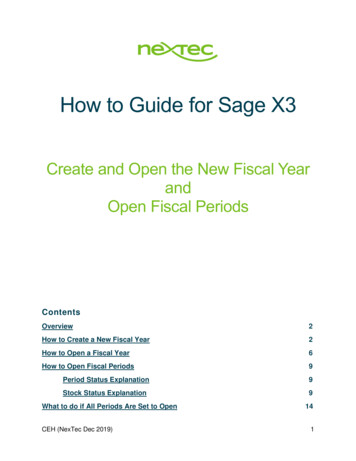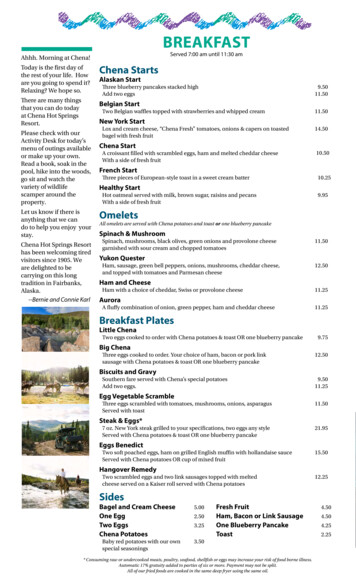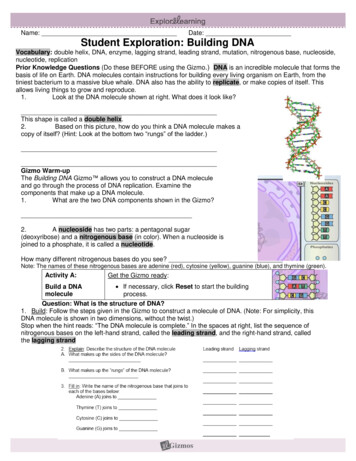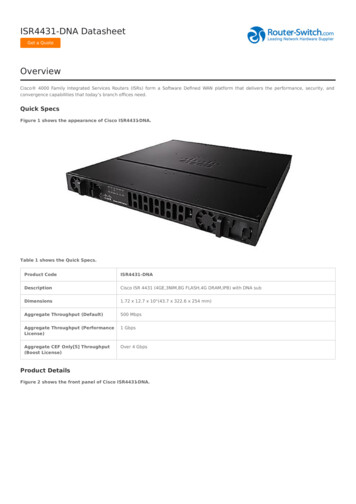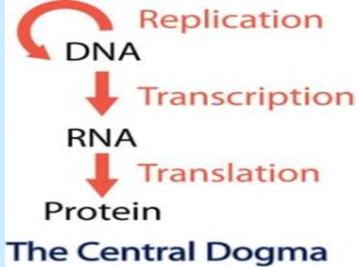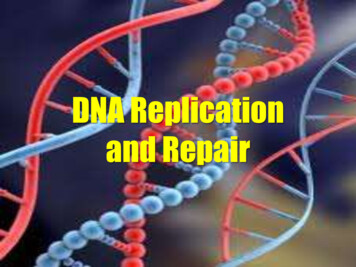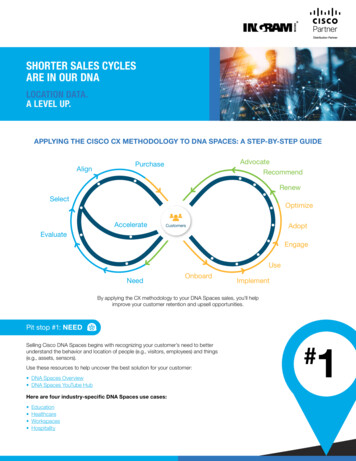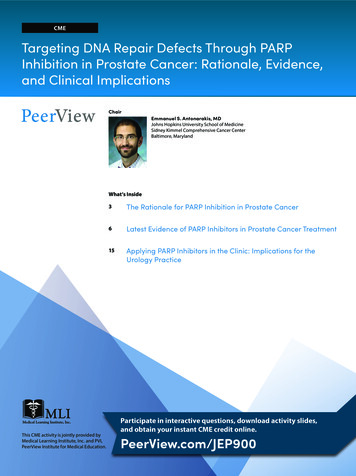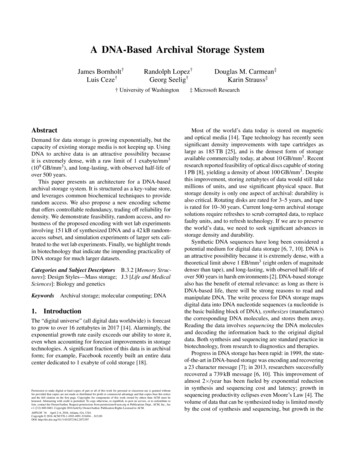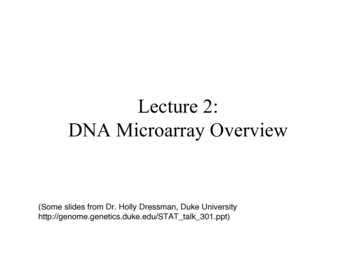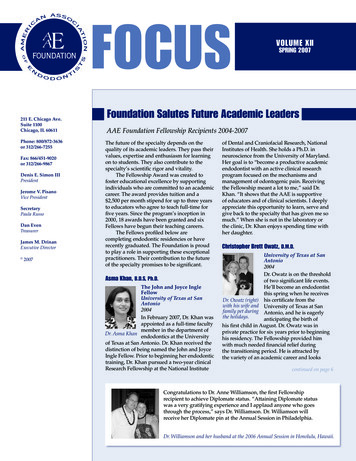
Transcription
Focus211 E. Chicago Ave.Suite 1100Chicago, IL 60611Phone: 800/872-3636or 312/266-7255Fax: 866/451-9020or 312/266-9867Denis E. Simon IIIPresidentJerome V. PisanoVice PresidentSecretaryPaula RussoDan EvenTreasurerJames M. DrinanExecutive Director 2007VOLUME XIISPRING 2007Foundation Salutes Future Academic LeadersAAE Foundation Fellowship Recipients 2004-2007The future of the specialty depends on thequality of its academic leaders. They pass theirvalues, expertise and enthusiasm for learningon to students. They also contribute to thespecialty’s scientific rigor and vitality.The Fellowship Award was created tofoster educational excellence by supportingindividuals who are committed to an academiccareer. The award provides tuition and a 2,500 per month stipend for up to three yearsto educators who agree to teach full-time forfive years. Since the program’s inception in2000, 18 awards have been granted and sixFellows have begun their teaching careers.The Fellows profiled below arecompleting endodontic residencies or haverecently graduated. The Foundation is proudto play a role in supporting these exceptionalpractitioners. Their contribution to the futureof the specialty promises to be significant.Asma Khan, B.D.S, Ph.D.The John and Joyce IngleFellowUniversity of Texas at SanAntonio2004In February 2007, Dr. Khan wasappointed as a full-time facultymember in the department ofDr. Asma Khanendodontics at the Universityof Texas at San Antonio. Dr. Khan received thedistinction of being named the John and JoyceIngle Fellow. Prior to beginning her endodontictraining, Dr. Khan pursued a two-year clinicalResearch Fellowship at the National Instituteof Dental and Craniofacial Research, NationalInstitutes of Health. She holds a Ph.D. inneuroscience from the University of Maryland.Her goal is to “become a productive academicendodontist with an active clinical researchprogram focused on the mechanisms andmanagement of odontogenic pain. Receivingthe Fellowship meant a lot to me,” said Dr.Khan. “It shows that the AAE is supportiveof educators and of clinical scientists. I deeplyappreciate this opportunity to learn, serve andgive back to the specialty that has given me somuch.” When she is not in the laboratory orthe clinic, Dr. Khan enjoys spending time withher daughter.Christopher Brett Owatz, D.M.D.University of Texas at SanAntonio2004Dr. Owatz is on the thresholdof two significant life events.He’ll become an endodontistthis spring when he receivesDr. Owatz (right) his certificate from thewith his wife and University of Texas at Sanfamily pet during Antonio, and he is eagerlythe holidays.anticipating the birth ofhis first child in August. Dr. Owatz was inprivate practice for six years prior to beginninghis residency. The Fellowship provided himwith much needed financial relief duringthe transitioning period. He is attracted bythe variety of an academic career and lookscontinued on page Congratulations to Dr. Anne Williamson, the first Fellowshiprecipient to achieve Diplomate status. “Attaining Diplomate statuswas a very gratifying experience and I applaud anyone who goesthrough the process,” says Dr. Williamson. Dr. Williamson willreceive her Diplomate pin at the Annual Session in Philadelphia.Dr. Williamson and her husband at the 2006 Annual Session in Honolulu, Hawaii.
From the PresidentDear Colleagues:to. Today, that vision is almost a reality. CloseNot long ago, a 20 million fund was a dreamingamazthisforensiblAAE members are respo 1 million is available for grants in 2007!y.rositgenesuccess. Thank you for your.Ipartner in advancing our philanthropic goalsEndodontic industry has also been a strong, willortersupprateonEndo, a long-standing corpoam extremely pleased to announce that Sybria.delphPhilainonrship donors at the Annual Sessihost a cocktail reception to recognize leadealsowilltsGueser.prior to the President’s DinnThe event will take place on Friday, April 27deddy performance. The company’s gift is intencomeall’senjoy preferred seating for Bill Engvfulgratelydeepisnnew giving. The Foundatioto recognize past generosity and to stimulate000ibutors. All donors with a pledge at the 10,controurrfor this special opportunity to honoif,levelnextthetoetoo late to take your pledglevel or higher are invited to attend. It’s nott.evenyou would like to attend this specials,to disburse our funds. As the endowment growThis is a pivotal year as we decide how bestmberincreasingly sophisticated. At the Novethe Foundation’s grant making is becomingded to strategic thinking. Emphasis was placeInterim Board Meeting, an entire day was devottheir impact.on analyzing current activities and evaluatingoved in 2006 included:A number of significant awards that were appral research studies via a Request for Proposal Up to 4 million over eight years for clinic31, 2007. This is a significant milestone forprocess. The proposal deadline was Januarythe specialty.—This seminar rotates annually among 90,000 for the 2007 Educator Workshoppredoctoral directors. Participants exploredepartment chairs, program directors andwith colleagues.academic issues, exchange ideas and networkdontic department in response to Hurricane 30,000 to Louisiana State University’s endoKatrina’s devastation.onlyal Endodontics Symposium—APICES is the 11,000 to the Advanced Programs in Clinicfor residents.educational program designed by residentson.the cost of attending the AAE Annual Sessi Funding to full-time educators to defraybeenof endodontic excellence. None would haveAll of these activities contribute to the goalthatnatefortuareWes.rests in its members’ handpossible without you. The specialty’s futureghthrouortsupp. Please continue to offer yourso many care so deeply about its well-beingvolunteerism and philanthropy.Sincerely,Denis E. Simon III, President Foundation FocusVol. XII Spring 2007
National Institutes of Health Awards 1.8 M to AAE Foundation FellowDr. Mo K. Kang, assistant professor of endodontics atthe University of California at Los Angeles, School ofDentistry, has been studying the molecular and cellularbiology of human oral mucosalcells for the past 10 years. Hispersistence paid off in January2007, when he learned that hewould receive a five-year 1.8million R01 research grant fromthe National Institute of Dentaland Craniofacial Research of theNational Institutes of Health. “Thisgrant has tremendous meaningDr. Mo Kangfor my academic career,” saidDr. Kang. “Junior faculty members depend largely onextramural research funds to advance their academiccareers and develop their independent researchprogram.”The goal of Dr. Kang’s study, Effects of AntiretroviralTherapy on Telomerase Function in Human Oral Epithelium,is to reduce or reverse the oral complications ofantiretroviral therapy in patients infected with HIV.“This intriguing cell type of the mouth, termed normalhuman oral keratinocytes (NHOK), is unique in thatthey express unusually high level of an enzyme calledtelomerase,” said Dr. Kang. “Our laboratory firstidentified the presence of this enzyme activity in NHOKand their importance in normal and healthy functionof human oral epithelium. Unfortunately, telomeraseenzyme functionally and structurally resembles theviral protein called reverse transcriptase of HIV, whichis the target of antiretroviral therapies at present.”HIV-positive patients therefore develop oral mucosalcomplications of antiretroviral therapies, includingmultiple oral ulcerations.Dr. Kang’s group is seeking to discover the statusof telomerase function in HIV-positive patients whohave taken the medications, such as AZT, for extendedperiods of time. They hope to develop adjunctivetherapies that will minimize the oral side-effects of theantiretroviral drugs. The researchers will test tissuesamples from patients to assess the reaction to varioussubstances. “This is a basic science study that will resultin a very specific and direct clinical application,” saidDr. Kang.Dr. Kang was the recipient of an AAE EndodonticEducator Fellowship Award in 2001. The Fellowshipprovided much needed financial support duringhis endodontic training at UCLA. Dr. Kang has alsoreceived first place Edward Hatton Awards for bothpredoctoral and postdoctoral categories from theInternational Association for Dental Research in 1999and 2002, respectively. In addition to his current workon the biology and the human oral epithelium, Dr.Kang is establishing an endodontic research program.He is investigating the process of dentin mineralizationattempting to identify novel cellular proteins necessaryfor reparative dentin formation.Dr. Kang’s interest in endodontics began whenhe was a dental student. He enjoyed the biologicaland surgical aspects of endodontic therapy and foundit rewarding to relieve patients’ discomfort and helppreserve their natural dentition. At present, Dr. Kang isalso actively involved in the endodontic teaching programat UCLA, where he chairs four didactic and clinicalcourses for the predoctoral and postdoctoral studentsand serves as the director for the Endodontic ResearchProgram for the postgraduate endodontic students.Dr. Kang noted that “being an AAE Educator Fellowconstantly reminds me that it is education that is theultimate responsibility and privilege of an academician.”In AppreciationThe AAE Foundation gratefully acknowledges these partners from industry for leadership support to endodonticresearch and education: 1,000,000Dentsply InternationalDentsply Tulsa Dental Specialties 75,000Global Surgical CorporationTreloar & Heisel, Inc. 280,000SybronEndo 50,000Aceteon North AmericaDiscus Dental SoftwareObtura SpartanUltradent Products, Inc.Carl Zeiss Surgical, Inc. 100,000PBS EndoSchick Technologies, Inc. 25,000ASI Medical, Inc.Biomet 3iCK Dental Specialties, Inc.EI-Endo IngenuityJ. Morita USA, Inc.Nobel Biocare, USA, Inc.Pentron Clinical TechnologiesPro-Dex, Inc.Sullivan-Schein Dental 35,000Charles B. Schwed, Inc.Vol. XII Spring 2007Foundation Focus
Strong Partnership Equals Strong Specialtylittle interest in fledgling projects. The idea of raisingan endowment arose from the realization that the onlyreliable source of funding for scientific and academicinitiatives would be practitioners themselves. No otherorganization or agency would provide this support.The dream of building an endowment to supportresearch and education linked the Foundation’s successto the specialty’s future. It also aligned the Foundation’sgoals with those of the AAE giving the organization amission that every member could appreciate. In 1994,From saving manatees to cutting taxes, people givethe Foundation was restructured to reflect this newto charities for reasons that are as unique as theirsynergy. To ensure communication between the twopersonalities. Because a contribution is often theorganizations the AAE president, president-elect, viceexpression of deeply held convictions, we thinkpresident and immediate past president would serveof generosity as being individual and private. Inon the Foundation’s Board of Trustees. To allow thereality, giving revolves around a complex network ofendowment to grow more rapidly, the AAE agreed torelationships. The interaction between the AAE andsupport the Foundation’s operating expenses.its Foundation is a good example of the importance ofThe success of this partnership is apparent.partnerships to successful philanthropy.Today, almost 20 million is invested in the fund andBefore writing a check, donors want to knowanother 5 million is pledged. Interaction betweenthat their contribution will make a difference. In thethe two organizations has evolved over time. AAEFoundation’s early years,President John S.that question mightOlmsted describeshave been difficult tothe relationship thisanswer. The Foundationway. “Our partnershipwas a small nonprofitis symbiotic. It isvaliantly attemptingcharacterized by strongto tackle challengesmutual respect.”beyond the scope of itsThe Foundationhuman and financiallooks to the AAE toresources. Prior to 1994,set the overarchingthe Foundation and thegoals and provideAAE did not coordinatespecial expertisetheir activities. Membersthat falls outside thewere either unaware ofresponsibilities of thethe Foundation, or notBoard of Directors.well informed aboutThe research grantits initiatives. Becauseinitiative is an ongoingthere was no process forarea of collaborationcollaboration betweenA meeting of the Endowment and Memorial Fund, the precursor tothat has been a modelthe two organizations,the current AAE Foundation, in the mid-1980s.for other joint ventures.the Foundation wasThe AAE Researchnot attuned to theand Scientific Affairs Committee sets the scientificAssociation’s goals and sometimes duplicated servicespriorities and evaluates the grants. The committee’sthat the Association was already providing. Its missionrecommendations are sent to the Foundation Board ofhad yet to capture the interest of its constituents.Trustees who approve the final funding.Compelling causes arise from critical needs. As theAs the philanthropic dollars grow, sharingspecialty grew, members became increasingly awareresources becomes even more critical to implementingof its stature in the dental health community. In 1989,effective programs. The average funding for a researchthe ADA Council on Dental Education’s denial of thegrant has been about 11,000. The smallest grants havespecialty’s application for re-recognition was a call tobeen about 1,000 and the largest around 35,000. Thisaction. AAE leaders recognized that without strongyear for the first time, the Foundation will considerresearch and educational initiatives the specialty wouldproviding up to 4 million over eight years for a clinicalnot attain the respect and recognition it deserved;research study. Proposals were solicited via a requestthey began to explore options. The government andfor proposal process. The AAE Research and Scientificindustry spend millions of dollars on research, but largeAffairs Committee and Evidence-Based Endodonticsdonors seek to advance their own priorities and have Foundation FocusVol. XII Spring 2007
Committee were both involved in writing the RFP.A special joint committee, which includes the chairsof both those groups plus the AAE and Foundationpresidents, was formed to oversee the review process.The Research and Scientific Affairs Committee willevaluate the proposals in consultation with experts inbiostatistics and clinical trials. Funding research at sucha significant level represents the fulfillment of a longawaited goal. It elevates the Foundation’s ability to takethe specialty to a new level.Strengthening endodontic education is a concernacross dentistry. It is the Foundation’s other majorarea of responsibility and perhaps its most significantchallenge. There is no easy way to assess whichstrategies will most effectively promote academicexcellence. Education is clearly an area where strongcollaboration between the AAE and the Foundationas well as outreach to other dental organizations isrequired.The Endodontic Educator Fellowship Awardwas the specialty’s first response to the need torecruit endodontic educators. The award, which wasinaugurated in 2001, was developed and continues tobe administered by a joint committee of AAE directorsand Foundation trustees. The committee interviewsapplicants and recommends candidates to theFoundation Board of Trustees. The Fellowship providestuition plus a stipend to residents who agree to teachfull-time for five years after graduation. The amount ofthe stipend was recently increased from 1,000 a monthto 2,500. A total of 18 Fellowships have been grantedand six fellows are currently teaching.In addition to recruiting new educators, theFoundation seeks to enrich the academic experience forcurrent faculty. Several collaborative initiatives highlightthe importance of professional development to careersatisfaction. Over the last three years the Foundationhas supported the AAE’s summer Educator Workshop.This weekend seminar, organized by the EducationalAffairs Committee, rotates among department chairs,program directors and predoctoral directors. In 2006, thefocus was department chairs with a total of 52 programsparticipating. Full-time faculty are also eligible for agrant that defrays half the cost of attending the AnnualSession and provides 250 for travel. To emphasizethe importance of continuing education, educators areeligible to receive an award of 2,000 when they achieveDiplomate status.The AAE’s new knowledge-based governanceprocess is providing the framework to take these firststeps to the next level. Knowledge-based governanceis an innovative approach to organizational leadership.Decision-making is based on facts, analysis anddiscussion. Recently, a committee composed ofFoundation trustees and AAE members used thesetechniques to develop a multifaceted faculty recruitmentVol. XII Spring 2007and retention program. After gathering information andconducting a thorough review of the data, they draftedrecommendations that were presented to the Boardsof both organizations. The final plan is a broad-basedinitiative that draws on the expertise of many differentcommittees working in conjunction with the Foundationand even other dental organizations. Initiatives rangefrom developing special workshops and forums foreducators to investigating loan forgiveness and signon bonuses. Some of the activities will be easy toimplement while others will probably require months ofpreparation and planning.The partnership between the AAE and Foundationdraws on the strengths of both organizations and createsthe possibility for large-scale change. The leadershipis committed to keeping this relationship strong andmaking sure it grows. “Each of us has contributesdifferent resources,” says Foundation PresidentDenis E. Simon III. “The AAE draws on the wealthof its members’ expertise from clinical knowledgeto marketing savvy. The Foundation provides thephilanthropic inspiration to create a culture of givingthroughout the specialty. The trustees are responsiblefor ensuring that the endowment is appropriatelystewarded.”“A strong relationship between the twoorganizations keeps our research and educationalinfrastructure growing,” says Foundation Vice PresidentJerome V. Pisano, “and that is essential for the survivalof the specialty.”A gathering of some of the first donors to contribute at or abovethe 25,000 level during the 1997 Annual Session, picturedfrom left to right: Drs. John Myers, Mahmoud Torabinejad,Richard Rubinstein, Gerald C. Dietz Sr., Herbert Schilder andMr. Mark Oliver.Foundation Focus
Foundation Salutes Future Academic Leaderscontinued from page forward to teaching in the classroom, the clinic and beinginvolved in practice.To better understand the academic lifestyle, Dr.Owatz participated in an Endodontic Preceptorship,which allowed him to teach part-time in theundergraduate endodontic clinic as part of his residency.The faculty at UTSA has also been a role model. “Theyare very unique people and they have all influenced orguided me in different ways,” says Dr. Owatz.In addition to training competent caring dentistsand endodontists, Dr. Owatz hopes to contribute to theresearch that is used in everyday practice to make clinicaldecisions. Right now, he is focused on completing histhesis as well as finding a faculty position. “Educatingfuture dentists is an awesome responsibility,” says Dr.Owatz. “I look forward to the challenge.”Natasha Flake, D.D.S., Ph.D.University of Washington2005Dr. Flake’s ideal academic positionwould be a balance of teaching, researchand clinical practice. She hopes to be amentor to all students who are interestedin research and the scientific basisDr. Flake at work of treatment approaches. Dr. Flake’sin the laboratory primary focus is the neuroscienceat the University of pain. The topic of her doctoralof Washington.dissertation was the pain associatedwith temporomandibular disorders. Dr. Flake h
PBS Endo Schick Technologies, Inc. 75,000 Global Surgical Corporation Treloar & Heisel, Inc. 50,000 Aceteon North America Discus Dental Software Obtura Spartan Ultradent Products, Inc. Carl Zeiss Surgical, Inc. 35,000 Charles B. Schwed, Inc. 25,000 ASI Medical, Inc. Biomet 3i CK Dental
